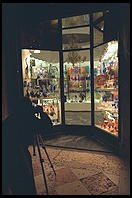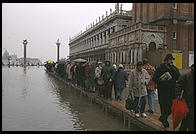
Chapter 1: Envisioning a Site That Won't Be Featured In suck.com
Revised June 2003

|
Chapter 1: Envisioning a Site That Won't Be Featured In suck.comRevised June 2003 |
 Why did the world buy 20 million expensive computers and
connect them together? Was it really so that a kid in Botswana
could look at a flashing GIF 89a logo from a Honda repair shop in
Sunnyvale, California? And, if we don't think that is true, what kinds
of Web services should we build?
Why did the world buy 20 million expensive computers and
connect them together? Was it really so that a kid in Botswana
could look at a flashing GIF 89a logo from a Honda repair shop in
Sunnyvale, California? And, if we don't think that is true, what kinds
of Web services should we build?
An alternative formulation of this question is "How can I design a site that won't be featured at http://suck.com?"
This book covers two broad categories of Web sites. The first is Web Publishing. These are sites that are vaguely magazine-like and include, as a degenerate case, the typical corporate product catalog site. The second broad category is Web-based Application. These are sites that do a job for a user, e.g., a site that keeps a dog's medical record and sends out email reminders when the dog needs immunizations. The first category is older and more familiar so let's talk about Web Publishing first.
 When you put up a magazine-like site, you are publishing. Virtually all
of the important decisions that you must make are publishing
decisions. Eventually you will have to select technology to support
those decisions, but that is a detail.
When you put up a magazine-like site, you are publishing. Virtually all
of the important decisions that you must make are publishing
decisions. Eventually you will have to select technology to support
those decisions, but that is a detail.
Start by putting yourself in your users' shoes. Why are they coming to your site? If you look at some Web sites, you'd presume that the answer is "User is extremely bored and wishes to stare at a blank screen for several minutes while a flashing icon loads, then stare at the flashing icon for a few more minutes." Academic computer scientists refer to this process of fitting software systems to people as "user modeling."
Slightly more content-rich sites are based on the user model of "User wants to look at product brochures" or "User wants to look at fancy graphics." After pulling the server logs for the sites that reflect these user models, though, it is tough to have much faith in them.
Consider that if a user wanted a flashing computer screen and confusing user interface, he could stuff a CD-ROM into the drive. He could get an even more enticing show without the crummy user interface by picking up his television remote control and flipping channels. If a user wanted product brochures, he could get them by calling manufacturers or visiting shops. If a user wanted fancy graphics, he could flip through dozens of pages' worth in a print magazine in the amount of time it would take to load a single corporate Web page.
Users come to magazine-like Web sites because they have questions. They are not bored losers. We are not doing them a favor by putting product brochures online or showing them huge logo GIFs. Users are doing us a favor by visiting our Web sites. They are paying to visit our servers, if not exactly with money then at least with their time. We have to give them something of value or they will never come back.
If you can anticipate user questions and make sure that your site answers them, you will be a successful Web publisher.
 Suppose that you are building a humble personal home page. Why would a
user come to your page? Someone might be trying to contact you or send
you a package. So you obviously need to include your phone number,
mailing address, and possibly fax number. Perhaps you've invited people
to your house for a party and they don't know how to get there; they
can't call you because you're out shopping for bagels. So you should
have a map to your house (see http://philip.greenspun.com/contact-info
for an example of simply hyperlinking an address to the Yahoo map server).
Suppose that you are building a humble personal home page. Why would a
user come to your page? Someone might be trying to contact you or send
you a package. So you obviously need to include your phone number,
mailing address, and possibly fax number. Perhaps you've invited people
to your house for a party and they don't know how to get there; they
can't call you because you're out shopping for bagels. So you should
have a map to your house (see http://philip.greenspun.com/contact-info
for an example of simply hyperlinking an address to the Yahoo map server).
Imagine that a friend of yours is at a party talking to Dale, a beautiful member of whatever sex you happen to fancy. Your friend is describing your charity, great humanity, and kindness to animals. Dale, however, won't agree to meet you without seeing a photo first. It would be nice if there were a portrait of you somewhere on your home page before Dale and your friend stroll over to the WebTV.
Or imagine that you've given an interview to a reporter on deadline. It is 2:00 am when the reporter realizes he forgot to ask you for some background biographical information. You'll be getting a wake-up call unless you remembered to put a copy of your resume online.
One would naively imagine that home or mobile phone numbers would be the information whose posting is most likely to be regretted. Sadly in our Great Age of Spam it is the email address that you'll probably be sorry that you added to your page. What you really want is a contact form on your Web site that only a real live human can use. If desired, the Web-initiated contacts can be emailed to the address of your choice, presumably an address that changes every time it falls into the hands of spammers.
"What makes an effective personal home page?" is a different question from "Why put effort into a personal Web site?" Speaking purely for myself, I built my site in order to share things that I'd learned, so that others could save time and avoid mistakes. Examples of articles that fit into this category include http://www.photo.net/travel/diving//decompression-illness and http://philip.greenspun.com/flying/caribbean.
 Consider www.nikon.co.jp.
Why would a photographer
come to this site? Possibly to look at brochures, so it might be nice if
there were advertising literature on the site. But the most important
users are existing customers, such as someone who is traveling with a
fancy Nikon single-lens reflex camera and has forgotten how to work the
flash. Caught without the owner's manual, this customer has surfed in
from an Internet café hoping to find the full text online.
Consider www.nikon.co.jp.
Why would a photographer
come to this site? Possibly to look at brochures, so it might be nice if
there were advertising literature on the site. But the most important
users are existing customers, such as someone who is traveling with a
fancy Nikon single-lens reflex camera and has forgotten how to work the
flash. Caught without the owner's manual, this customer has surfed in
from an Internet café hoping to find the full text online.
Someone with a broken camera will want to know how to get it fixed and how much it will cost. They'll be looking for maps to service centers, warranty details, and prices for out-of-warranty repairs. The site is a natural focal point for customers to meet, interact, and share experiences with each other. So www.nikon.co.jp should have moderated Q&A forums, bulletin boards, and classified ads where customers can contribute.
The preceding advice sounds trivial but try to find a product manufacturer who is following it. If you visit the average company's Web site, you find lots of advertising to potential customers but virtually no services or documentation for existing customers. In this sense the Web is kind of like early television. People didn't understand the new medium so they stuck a camera at the back of a live theater, recorded the movements and speech of the actors, and broadcast the result. On the Internet, companies have produced Web sites by sticking a camera in front of their marketing and sales brochures.
As of August 1998, www.nikon.co.jp was amply stocked with advertising. If you were at an Internet café and needed to review the instruction manual for your Nikon camera, you'd find instructions for going to the post office, purchasing six International Reply Coupons, and mailing them to Japan. Upon receipt of the coupons, Nikon would mail you the relevant manual. There were no tools for collaboration among customers, but you could send Nikon email. However, they asked you to first read the following disclaimer:
Nikon Corporation (" Nikon ") has no obligation for monitoring any ideas,
concepts, suggestions or comments (hereafter collectively called " Ideas " ) you
transmit to this Site (" the Site ") by electronic mail or otherwise.
Nikon understand that you abandon all rights regarding the Ideas at the time when
you transmit the Ideas to Nikon, and Nikon has no obligations to keep the Ideas
confidential.
Nikon has no responsibility for any problems or issues resulted from the Ideas.
For a glimpse of what a corporate site looks like when a company
thinks about existing customers, look at
www.ge.com.
They have advertisements, yes, but also
owner's manuals and installation guides for every GE product. If you
moved into an apartment with a GE appliance but the previous tenants did
not leave you the instructions, you can grab a PDF file from the GE site
and print it.
 One day while working at the MIT Laboratory for Computer Science,
some folks in the building came to our corner with their plan for the new
www.lcs.mit.edu.
The site would have a mission statement from the lab director and a list of
all the groups in the lab. For each group, we'd indicate which
professor was in charge and the mission statement for that group. The
overall goal was to attract undergraduates at other universities to
apply here for graduate school and to attract graduate students at other
universities to apply here for faculty jobs. The site would be produced
through four levels of management with the directors telling the PR
staff what they wanted to say, the PR staff telling a writer what to
write, and the writer's words going to a graphic designer for formatting
into HTML.
One day while working at the MIT Laboratory for Computer Science,
some folks in the building came to our corner with their plan for the new
www.lcs.mit.edu.
The site would have a mission statement from the lab director and a list of
all the groups in the lab. For each group, we'd indicate which
professor was in charge and the mission statement for that group. The
overall goal was to attract undergraduates at other universities to
apply here for graduate school and to attract graduate students at other
universities to apply here for faculty jobs. The site would be produced
through four levels of management with the directors telling the PR
staff what they wanted to say, the PR staff telling a writer what to
write, and the writer's words going to a graphic designer for formatting
into HTML.
Our comments?
It would be a nice 20-page site that would cost about $100,000 a year to maintain because every change would have to go up and down this four-level management chain. Assuming Lab HQ had the budget to do it, we could only see one little problem.
"What's the problem?" asked the PR folks.
"If you walked out of this building and spent the rest of your life searching the planet, I don't think you'd find a single person who cared about the names of the groups at LCS or who was running them."
Our suggestion was first to think about Jane Nerd, a computer science undergraduate at the University of Michigan. She is interested in network protocols. She should be able to type "network protocols" into a search box and learn something interesting about the history, practice, and future of computer networks. In the process she would probably discover that our very own Dave Clark was Chief Protocol Architect for the Internet from 1981 to 1989 and that the Advanced Network Architecture Group at LCS is tackling the problem of making one Internet protocol work simultaneously for real-time control, video conferencing and other forms of interactive collaboration, plus traditional data transfer. If she is curious about encryption, she should find the Internet's best tutorial on the workings of the RSA algorithm. In the process, she might learn that LCS employs Ronald Rivest, the "R" in RSA and that Ron is part of the Theory of Computation Group.
Next we should think about Joe Maxinerd, finishing his Ph.D. in computer science at Stanford. Joe's thesis is on computer graphics. He should have been visiting one of our Web servers every day or two because we are operating a community Web site where the world's leading experts in graphics algorithms meet to exchange research results, talk about new ideas, and teach students. As a participant in forums and from reading comments on research papers, he would be intimately familiar with all the MIT LCS folks who work in the Computer Graphics Group.
We should think about teaching. A quick review of our server logs will reveal that the entire world doesn't come here every day desperate to find out what we're doing. If we want traffic, we'll have to give something back to the Internet. Fundamentally, there are two ways of teaching a scientific or technical subject. The standard textbook takes the "here's the way it is" approach. You don't learn about how people struggled to understand electric and magnetic fields over 2500 years; you get Maxwell's equations. It doesn't have to be this way. At St. John's College (www.sjca.edu), students learn physics by reading original writings by Aristotle, Newton, Kepler, Maxwell, Einstein, Heisenberg, and Millikan.
Nearly all computer science tutorials take the "here's how you do it" approach. With such a short history behind the field and instructors who tend to be ignorant of that history, colleges generally just show students a point-in-time snapshot of thinking about computing. LCS is 35 years old this year, so we're one of the few institutions that has been around long enough to talk credibly about the history of the field.
What would make a great LCS site is a collaboratively produced, collaboratively taught history of computer science. Journalists, historians, and other casual users might wish to read the timeline of technological advances and click through to see explanations of what each advance brought in terms of applications. Thus, for example an entry on early bitmap displays (Stanford, Knight TV, Xerox PARC) would be linked to an explanation of how they led to the MIT Lisp Machine, the Macintosh and then Microsoft Windows. Computer science students would be able to learn all of computer science by following hyperlinks from the timeline to original papers and software. In doing so, they would note that much of the innovation in computer science happened at MIT and perhaps become inspired to apply for positions here.
Because we would farm out responsibility for each section of the timeline to a professor and the responsibility for running community sites in research areas to the various groups, the overall cost of this kind of site would probably be similar to that of the 20-page site produced with a four-level management hierarchy.
The point of this example? A publisher's internal structure is of no interest to Web users. People come to Web sites looking to get a job done or a question answered. The first thing the guys at www.fedex.com did was publish a Web interface to their package tracking database. That was back in 1994. When they decided to add corporate information they put it on an entirely separate site: www.fdxcorp.com. (Today the sites are merged.)
Edward Tufte makes the point that "design recapitulates bureaucracy" on page 148 of Visual Explanations [1997].
 You can objectively measure how well your site meets user needs. Are you
getting a lot of e-mail questions? As soon as two users ask the same
question, you should beef up your site to answer it unattended: Build a
page, fix the navigation model, or tune your search engine.
You can objectively measure how well your site meets user needs. Are you
getting a lot of e-mail questions? As soon as two users ask the same
question, you should beef up your site to answer it unattended: Build a
page, fix the navigation model, or tune your search engine.
Every competently run site runs a local full-text search engine. Why not go the extra mile and hack the CGI scripts so that the search engine sends you e-mail when a query results in zero matches? Given information about which user queries are failing, you can add content or keywords as appropriate.
At this point you can relax. You aren't a loser with a big budget, a lot of ugly graphics, and no traffic. Users are not leaving your site in frustration, shaking their heads, and saying "They just don't get it." Now that you are safe from the wags at suck.com, what can you do to make your magazine-like site fulfill its potential?


Do these not suggest a somewhat richer place than the sentence in the Michelin guide? Yet the sight of a tourist slavishly following the Michelin guide is a commonplace. Something really fascinating and unexpected is happening in front of him, but he has his nose buried in the guide, trying to figure out what the next official point of interest is. The tourist is literate. Not literate in the "I read Classics at Oxford" sense, but literate in the "knowledge is closed" sense. Everything about Italy can fit into a book. Perhaps the 350 pages of the Green Guide aren't enough, but some quantity of writers and pages would suffice to encapsulate everything worth knowing about Italy.
 Oral cultures do not share this belief. Knowledge is open-ended. People
may hold differing opinions without one person being wrong. There is not
necessarily one truth; there may be many truths. Though he didn't grow
up in an oral culture, Shakespeare knew this. Watch Troilus and
Cressida and its five perspectives on the nature of a woman's
love. Try to figure out which perspective Shakespeare thinks is correct.
Oral cultures do not share this belief. Knowledge is open-ended. People
may hold differing opinions without one person being wrong. There is not
necessarily one truth; there may be many truths. Though he didn't grow
up in an oral culture, Shakespeare knew this. Watch Troilus and
Cressida and its five perspectives on the nature of a woman's
love. Try to figure out which perspective Shakespeare thinks is correct.
Feminists, chauvinists, warmongers, pacifists, Jew-haters, inclusivists, cautious people, heedless people, misers, doctors, medical malpractice lawyers, atheists, and the pious are all able to quote Shakespeare in support of their beliefs. That's because Shakespeare uses the multiple characters in each of his plays to show his culture's multiple truths.
In the 400 years since Shakespeare we've become much more literate. There is usually one dominant truth. Sometimes this is because we've truly figured something out. It is kind of tough to argue that a physics textbook on Newtonian mechanics should be an open-ended discussion. Yet even in the natural sciences, one can find many examples in which the culture of literacy distorts discourse.
If you were able to stay awake long enough to read through an academic journal for taxonomic botanists, you'd learn that not all botanists agree on whether Specimen 947 collected from a particular field in Montana is a member of species X or species Y. But you'd see quite clearly that everyone publishing in the journal agreed on the taxonomy, i.e., on how to build a categorization tree for the various species.
However, if you were able to stay awake long enough to get through a cocktail party in a university's department of botany, you'd discover that even this agreement is illusory. There is widespread disagreement on what constitutes the correct taxonomy. Hardly anyone believes that the taxonomy used in journals is correct but botanists have to stick with it for publication because otherwise older journal articles would be rendered incomprehensible. Taxonomic botany based on an oral culture or a computer system capable of showing multiple views would look completely different.
Open today's New York Times. A Republican politician is arguing for relaxed regulations on widgets. A Democrat is quoted arguing in favor of tightened regulations. There is a vote; widget regulations are tightened. On the surface, it looks like multiple perspectives. Yet at a cocktail party, your friend Sue argues that the government shouldn't be regulating widgets at all. Joe interrupts her to say that widget regulation is a canard; we really ought to talk about flag burning. Dana brings up the Simpsons episode where Bart went on a school field trip to the widget factory. Alan tells his grandfather's widget factory stories from World War II. Elizabeth talks about how she was surprised to see that they had no widgets in New Zealand and apparently did not miss them. Compared to the texture of the cocktail party, the New York Times article sounds like two rich old white guys saying more or less the same thing.
Some people like a one-truth world. If you have a huge advertising and PR budget then you can control your public image very effectively in a literate world. Ford Motor Company has enough money to remind you 2,000 times a year that "Quality is Job One"; unless your friend was roasted in a Pinto gas tank explosion, you probably will eventually come to agree. Microsoft via the genius of Bill Gates invented the mouse-windows user interface, reliable operating systems, affordable computing, and the Internet; if you don't think all that is true, ask someone who has never used a computer and whose only exposure to the industry is through mass media.
Unless you have the billions of dollars necessary to create a one-truth world of your own, you'll probably come to agree that the greatest artistic achievements hold the mirror up to a multiple-truth life.
The Internet and computers, used competently and creatively, make it much easier and cheaper to collect and present multiple truths than in the old world of print, telephone, and snail mail. Multiple-truth Web sites are much more interesting than single-truth Web sites and therefore will get a lot more traffic. For example, the car manufacturers' sites are mostly collections of product brochures tarted up with flashing graphics. They get minimal traffic compared to the plain text rec.auto.* newsgroups, which present the real experience of car owners from around the world. The newsgroups don't have pictures, animation, sound, or video clips, but they have multiple truths.
Okay, enough philosophy and Shakespeare. This is the point in the infomercial where the guy wearing the CAT Diesel cap asks, "Do I need a college education to build one of these here multiple-truth Web sites?" The answer is no.
As a site evovles you may find that your happiest hours are spent watching users answer each other's questions.
You don't have to be a traditional publisher to benefit from the
collaboration systems that you'll learn how to use by reading the rest
of this book. Manufacturers can collect and redistribute consumer
comments about dealers who carry their products. Academic researchers
can collect comments, ideas, and questions sparked by their writings.
Does this sound like too much work? If your site is commercial and you claim to be a smart businessperson, then you ought to be able to figure out a way to interact with users more cheaply over the Internet than via 800 numbers. If you are a writer or a photographer who has built a non-commercial site, disintermediating the publisher means total artistic freedom. User feedback might be annoying at times, but if you want to be insulated from your readers, why publish on the Web at all?
What happens if you take all of these steps? Sometimes magic. Here's a passage from Part 2 of my Berlin/Prague story (http://www.photo.net/bp/part2):
"Die Neue Synagoge on Oranienburger Strasse had a tired Oriental look and was under restoration. This building demonstrates the power of a single person of conscience. When the Nazis rolled around on Reichkristallnacht and set fire to the synagogue, a lone policeman decided that it was a valuable historical building. He got a fire brigade to put the fire out and then arranged an all-night guard for the place. His efforts were ultimately in vain, for the Nazis had learned something from the Turks in Athens: when you want something to be destroyed, e.g. the Parthenon, put a lot of explosive stuff inside and wait for an accident. Thus the building was used as an ammo dump and an Allied bomb blew the place to smithereens in 1943."I'd cribbed the facts from a guide book and would never have realized that they were wrong if not for the "add a comment link" and a year of time passing. Here's one of the first comments that appeared underneath the article:
"I read your article about Berlin with great interest. For the sake of accuracy, the Nazies did not place ammunition in the Neue Synagoge. It was used as a warehouse. The basement was used as an office. The place was bombed and the main sancturary was burned out, only the front part and the walls were kept standing. After the War, the East Germans blew up the the remains of the sanctuary, "Safety Reasons". The front was left to decay. The front part has been rebuilt, and now it is beeing used as a learning center. How do I know. I lived in the Synagogue from before the War until my arrest and eventual incarceration to Auschwitz May 7. 1943. After my Liberation in 1945, I came back there and visited the place. In 1994, I went back to Berlin on a visit, and naturally I went to see the place. At that time they were rebuilding the place. In the rubble they had found papers of mine from 1937 to relating to my Barmitzwah. A year later, I was invited to the rededication ceremony."It seems safe to assume that people are likely to accept his version of the facts as authoritative. No paper book is ever going to collect a story like this. Nor can a paper book connect its readers with each other but this Web article did. In 1999 a Holocaust researcher managed to locate Mr. Rowe and interview him because he had left his email address underneath his comment. She wrote me a thank-you email.
-- Contributed by Harry S.Rowe on April 26, 1997
[Figure 1-1 for the paper book:
 the question and answer
forum in http://www.photo.net/photo,
which contains more than 25,000 archived messages. Answers are e-mailed
automatically to the user who posted the question, even months later.
Users can choose to be notified by e-mail of new messages instantly,
daily, or weekly.]
the question and answer
forum in http://www.photo.net/photo,
which contains more than 25,000 archived messages. Answers are e-mailed
automatically to the user who posted the question, even months later.
Users can choose to be notified by e-mail of new messages instantly,
daily, or weekly.]
www.michaelmoore.com is a site that exists primarily to encourage people to purchase hardcopy books. Mr. Moore has had enormous commercial success distributing his writings and films through traditional channels and therefore he doesn't apparently feel the need to reach an additional audience via the Web. Mr. Moore would tell you that he is a champion for poor and working-class Americans but his site makes it seem as though his main interest in those people is that they spend $20 on his book.
By contrast John S. Denker makes no claims to be serving the underclass. He is a PhD physicist at Bell Labs who is the author of one of the world's best books for beginner pilots: See How It Flies. Although one presumes that John Denker isn't Hollywood wealthy like Michael Moore, he is somehow able to afford to put the full text of his book online at http://www.av8n.com/how/. Instead of a teaser asking people to buy his book, Denker provides the book.
Why is Denker's site so much better than Moore's? For Denker, the Web is his primary distribution medium. For Moore the Web is an adjunct to a successful career in traditional media so he can be forgiven for not caring that his site is lame.
 Sites that are adjuncts to physical events almost always disappoint. In
October 1995, the MIT Media Lab threw itself a tenth anniversary party.
The physical event was fabulous: little gifts for everyone, cleverly
packaged; a Photomosaic poster by Rob Silvers; women in plastic
pants. As an adjunct to the physical event, the Media Lab was going to
create the best Web site ever: www.1010.org. They got Verizon to bring
in a dedicated 45-Mbps T3 network connection so that packets requested
by millions of users would not get slowed down working their way through
MIT's backbone before getting to the wider Internet. Hewlett-Packard
donated several racks of of multiprocessor machines with disk
arrays. The Media Lab hired expert consultants to plug all the computers
in and hook them up to the network. They hired professionals to do
graphic design and site layout for www.1010.org.
Sites that are adjuncts to physical events almost always disappoint. In
October 1995, the MIT Media Lab threw itself a tenth anniversary party.
The physical event was fabulous: little gifts for everyone, cleverly
packaged; a Photomosaic poster by Rob Silvers; women in plastic
pants. As an adjunct to the physical event, the Media Lab was going to
create the best Web site ever: www.1010.org. They got Verizon to bring
in a dedicated 45-Mbps T3 network connection so that packets requested
by millions of users would not get slowed down working their way through
MIT's backbone before getting to the wider Internet. Hewlett-Packard
donated several racks of of multiprocessor machines with disk
arrays. The Media Lab hired expert consultants to plug all the computers
in and hook them up to the network. They hired professionals to do
graphic design and site layout for www.1010.org.

The site launched without any magnet content. Nobody had written any
stories or taken any pictures. Every day a Media Lab editor posed a
question and then sat back to watch a USENET-style discussion evolve. There were
only a handful of postings in each area. One user had contributed a
smiley face: colon dash right-paren. That was his entire message. This
wasn't as shocking as the fact that, on a scale of 1 to 7, this posting
had been rated 4.3 by other users. Yes, several other users had taken
the trouble to rate this three-character posting. When the 10-day Web
event was over, the massive disk arrays held almost enough
user-contributed data to fill two 3.5-inch floppy disks.

How could so much money and hardware have resulted in a site that an elementary school would have been embarrassed to make public? The Web site wasn't primary. The party was the important thing. The Media Lab, one of the last groups at MIT to put up a Web site, had no real Internet culture. They wanted to reach corporate managers and bring them into the physical space of the Lab. Since corporate managers in 1995 didn't tend to have a TCP/IP connection on their desktop, it wasn't obvious how Internet would be useful in attaining the Media Lab's goals.
Don't try to visit www.1010.org. The Media Lab eventually got Web-savvy enough to realize the embarrassment value of such a site and pulled the plug on the server.
Money is nice. Bandwidth is nice. Graphic design is occasionally nice. But if you treat your Web site as a pimple on the butt of something much larger then it will probably be ripe for suck.com.
So that you don't have to break into tomorrow's Prozac supply, let me close this section on a happy note: http://www.dannen.com/szilard.html, Gene Dannen's biography of Leo Szilard, the Hungarian-Jewish theoretical physicist who made the atomic bomb work and then tried to stop Roosevelt from using it. Dannen says that he is writing a book but surely the Web is a richer place because he got distracted from finishing it and did this site instead. Since there isn't a "Szilard, the Movie" or "Szilard, the Book" or "Szilard, the Museum", Leo Szilard Online ended up a rich and fascinating site.
Let's shift gears now from the first site category (Web publishing) and consider the second category: Web-based applications.
 Sadly there isn't too much that is exciting in the world of I.T. just
now. If you interview 100 Americans and ask "Would you rather have a
bigger SUV or a better information system?", probably 99 would opt for
the bigger SUV. It is tough to say when or if people will start to ask
more from their silicon servants but in the meantime it is easy to say
that most of the excitement and possibility is within Web-based
applications.
Sadly there isn't too much that is exciting in the world of I.T. just
now. If you interview 100 Americans and ask "Would you rather have a
bigger SUV or a better information system?", probably 99 would opt for
the bigger SUV. It is tough to say when or if people will start to ask
more from their silicon servants but in the meantime it is easy to say
that most of the excitement and possibility is within Web-based
applications.

Interesting things can happen when you do something as simple as move an application from the desktop to a server. For example, at a small company once we had the idea of building a server-based replacement for PowerPoint. We wanted something simpler that we could edit from any Web browser. Once the slides were in the database, however, we realized that this could be used for collaboration. User A could authorize User B to edit a presentation and the two of them could authorize User C to give that presentation at a remote site.
Only after talking to people from PowerPoint-oriented organizations did we realize how revolutionary the system, which we called "WimpyPoint", could be. Suppose Jane Executive went on vacation for three weeks. Upon her return she wouldn't have to start calling colleagues to find out what had been going on; she could look at the WimpyPoint server and ask to see all presentations created within the last three weeks. When all the work of an organization is presented within PowerPoint it is a terrible waste to have that work locked up in monolithic files.
Before you get too excited about the WimpyPoint idea, which only took a few days to program, go to www.edwardtufte.com and order a copy of "The Cognitive Style of PowerPoint" to realize just how debased our culture has become.
Many of the following chapters in this book are directed at helping you
engineer Web-based services in such a way that users have a pleasant
experience while minimizing your costs.
This chapter was about people talking to computers and people talking to
each other with a computer mediator. The next chapter is about how
computers talking to each other could finally deliver all of the
benefits that the Computer Age was supposed to have conferred on us
(and, if you insist, how you can make a buck off of it).
The Nikon web site is much improved as of 2004. You can get a manual in PDF format for any camera.
-- Michael Domino, October 12, 2004
Alejandro "Alex" Ramirez writes:The instruction on multiple truths looks good on paper, but let's talk about its functionality: I am, in real life, a Web Design class student who just finished reading this page. I was confronted by the comment refuting Nikon's website's criticism. What happens when the graduated Webmaster: makes a website, carefully plans and choreographs it to present his/her view, and then hosts a contradictory account at the end? Answer: Uselessness. The person who has just rewarded the webmaster with his valuable Time will leave, possibly, more Against than for what was expressed in the entire website. Such as, when 1) someone thinks "The author's site says some good things but- Hey, if this person is offering guidelines on web publishing, why does their site look so low on design quality?" (which happens all the time after reading webmaster's instructional sites) or 2) someone does not agree with multiple truths. Truth is not relative; only perspectives and opinions are. Example:
Neglected wife seeks fellowship with other male figures outside of her partner,
Misinterpreting husband assumes marital infidelity,
Confronted wife expresses the misinformation and illusion which is being held;
Unreachable husband murders his wife.
What was the truth? Summed up from an omniscient view in Example one. What were the multiple truths?
Wife: That loser of a workaholic doesn't care about me. I just want a friend who will listen to me.
Husband: I am trying my best to be a provider for this too-demanding woman.
The following are not just multiple truths; they are part of the one "Truth" which can only be appreciated from an omniscient narrator to this story:
Wife: I'm not cheating! There is no emotional involvement and no physical contact with my male friends! I haven't even been alone in the same place with them!
Husband: I work all day and come home to find answering machine messages from Joe Shmoe and Guy Doe!
These next comments would be "multiple truths" offered by for or against supporters in the court case for the murdering husband:
"Put that animal to sleep!"
"The gentleman just suffered from some work stress and communicational breakdown barriers. He should be spared the sentence."
"Being faithful to him, and then dying at his hand? An eye for and eye!"
"Ah, that woman got what was coming to her. You don't have to kiss to cheat on a guy!"
And the opinions (a.k.a. multiple truths,...) go on and on.
The example of the Berlin/Prague story shows just the very argument for multiple truths: "Although many different opinions might be held, there is only one valid one: the omniscient point of view." Our invisible author would write: 1) A gentleman wrote a story which contained his idea of what happened, and; 2)another gentleman had another take on the story, because he was there or claimed to be there and have actual first-person knowledge of the site and events which were quoted.
None of us can stake a claim to saying only the truth or holding one of the many individual truths that are supposedly existent. Therefore, the theory should be rewritten: "Each one holds a view or opinion to the one truth of which no mere human can be the sole owner. Every individual has the right to hold his or her view on any number of subjects, places, or events. Nonetheless, no one of these should be the basis for any decision being made."
This sums up my difficulty with the opinion that is held. I have to do a paper for a college web design course in which the teacher obviously agreed with this, but not necessarily with the rest of the opinions expressed in the book. After having to read through each paragraph several times, I first tried to understand everything that is being said. This might be from lack of clarity in each sentence expression, or lack of clarity in the expression of a true thing. My opinion (or fragment of the truth) states this caused part of the failure of the WWW. More user time seems spent deciphering through differing opinions and motives than ever becoming conversant in any area or discipline.
If this discussion was not allowed, then the average reader would have to accept the information being told as an absolute. However; users can hold to narrow-minded opinions; I'll make a list. Let's say, justifying genocide, domestic violence in other-than-American-cultures, class structure which maintains the rich rich and the poor poor, incest, rape, bigamy, bestiality, and/or our children's bombardment with graphic images of all this at schools. Allowing everyone's opinion in schools, politics, and even websites would be a very good way of making a free marketplace for militants to find apprentices to their view of life.
This site gets an A+ in functionality, browsing through and excellent for user input. However, my previous assignments taught me the same things without having to convince the world that the author still has his Berlins.
-- Alejandro Ramirez, February 13, 2005
Alejandro: Your point makes the assumption that an omniscent POV can be reached by any partaking individual. This is sorely mistaken. Perhaps there is an omniscient POV. No single human can come to the concluion on their own.To make the internet serve the views of an omniscient POV is, in reality, to make the internet serve the purposes of a tyrannical warlord. You need multiple views to ensure fairness and discourse away from genocide or such. After all, genocide does not come about from a free airing of free-market ideas, but from a tightly controlled propaganda system shoved down consumer's throats. The internet provides a way to change this, by allowing individuals to stack up on as many different sides of a situation as they can, and thus, coming as close to a true Omniscent POV as possible.
-- Jose Luis Nunez, May 31, 2008